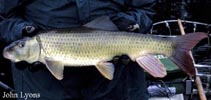http://www.fishbase.org/Summary/speciesSummary.php?genusname=Moxostoma&speciesname=carinatum ---> http://52.67.158.155/Summary/speciesSummary.php?genusname=Moxostoma&speciesname=carinatum
http://52.67.158.155/Summary/speciesSummary.php?genusname=Moxostoma&speciesname=carinatum ---> https://fishbase.net.br/Summary/speciesSummary.php?genusname=Moxostoma&speciesname=carinatum
https://fishbase.net.br/Summary/speciesSummary.php?genusname=Moxostoma&speciesname=carinatum ---> https://fishbase.net.br/summary/Moxostoma-carinatum.html
Moxostoma carinatum, River redhorse : gamefish

You can
sponsor
this page
Common name (e.g. trout)
Genus + Species (e.g. Gadus morhua)
-

-
About this page
-
Languages
-
User feedbacks
-
Citation
-
Uploads
-
Related species
-


 River redhorse
Upload your
photos
and
videos
River redhorse
Upload your
photos
and
videos
Pictures
|
Google image
 Moxostoma carinatum
Moxostoma carinatum
Picture by
Lyons, J.
Teleostei (teleosts) >
Cypriniformes
(Carps) >
Catostomidae
(Suckers) > Catostominae
Etymology:
Moxostoma:
Greek, myxo = to suckle + Greek, stoma = mouth (Ref.
45335
)
;
carinatum:
From the word
carinatum
, meaning keeled (Ref.
10294
)
.
More on author:
Cope
.
Environment: milieu / climate zone / depth range / distribution range
Ecology
Freshwater; demersal. Temperate; 47°N - 31°N
North America: St. Lawrence River-Great Lakes and Mississippi River basins from southern Quebec in Canada to central Minnesota and western Iowa in USA, and south to northern Alabama and eastern Oklahoma, USA; Gulf Slope drainages from Escambia River in Florida to Pearl River in Louisiana and Mississippi, USA.
Size / Weight / Age
Maturity: L
m
?
range ? - ? cm
Max length : 77.0 cm TL male/unsexed; (Ref.
5723
); common length : 48.0 cm TL male/unsexed; (Ref.
12193
); max. published weight: 4.0 kg (Ref.
40637
); max. reported age: 12 years (Ref.
12193
)
Inhabits rocky pools and swift runs of small to large rivers. Also occurs in impoundments (Ref.
5723
,
10294
). Locally common but disappearing from northern and western parts of range (Ref.
5723
). Adult feeds on small bivalve mollusks (Ref.
10294
).
Life cycle and mating behavior
Maturity
|
Reproduction
|
Spawning
|
Eggs
|
Fecundity
|
Larvae
Page, L.M. and B.M. Burr
, 1991. A field guide to freshwater fishes of North America north of Mexico. Houghton Mifflin Company, Boston. 432 p. (Ref.
5723
)
IUCN Red List Status (Ref.
130435
)
Least Concern (LC)
; Date assessed:
01 March 2012
CITES
Not Evaluated
Not Evaluated
Threat to humans
Harmless
Human uses
Gamefish: yes
FAO - Publication:
search
|
FishSource
|
More information
Countries
FAO areas
Ecosystems
Occurrences
Introductions
Stocks
Ecology
Diet
Food items
Food consumption
Ration
Common names
Synonyms
Metabolism
Predators
Ecotoxicology
Reproduction
Maturity
Spawning
Spawning aggregation
Fecundity
Eggs
Egg development
Age/Size
Growth
Length-weight
Length-length
Length-frequencies
Morphometrics
Morphology
Larvae
Larval dynamics
Recruitment
Abundance
BRUVS
References
Aquaculture
Aquaculture profile
Strains
Genetics
Electrophoreses
Heritability
Diseases
Processing
Nutrients
Mass conversion
Collaborators
Pictures
Stamps, Coins Misc.
Sounds
Ciguatera
Speed
Swim. type
Gill area
Otoliths
Brains
Vision
Tools
E-book
|
Field guide
|
Identification keys
|
Length-frequency wizard
|
Life-history tool
|
Point map
|
Classification Tree
|
Catch-MSY
|
Special reports
Check for Aquarium maintenance
|
Check for Species Fact Sheets
|
Check for Aquaculture Fact Sheets
Download XML
Summary page
|
Point data
|
Common names
|
Photos
Internet sources
AFORO (otoliths) |
Aquatic Commons
|
BHL
|
Cloffa
|
BOLDSystems
|
Websites from users
|
Check FishWatcher
|
CISTI
|
Catalog of Fishes
:
genus
,
species
|
DiscoverLife
|
ECOTOX
| FAO - Publication:
search
|
Faunafri
| Fishipedia |
Fishtrace
| GenBank:
genome
,
nucleotide
|
GloBI
|
Google Books
|
Google Scholar
|
Google
|
IGFA World Record
|
MitoFish
|
Otolith Atlas of Taiwan Fishes
|
PubMed
| Reef Life Survey | Socotra Atlas |
Tree of Life
| Wikipedia:
Go
,
Search
|
World Records Freshwater Fishing
|
Zoological Record
Estimates based on models
Phylogenetic diversity index (Ref.
82804
): PD
50
= 0.5000 [Uniqueness, from 0.5 = low to 2.0 = high].
Bayesian length-weight: a=0.01000 (0.00534 - 0.01873), b=2.95 (2.79 - 3.11), in cm total length, based on LWR estimates for this species & Genus-body shape (Ref.
93245
).
Trophic level (Ref.
69278
): 3.6 ±0.50 se; based on food items.
Resilience (Ref.
120179
): Low, minimum population doubling time 4.5 - 14 years (tmax=12).
Fishing Vulnerability (Ref.
59153
): Moderate to high vulnerability (51 of 100).
Back to Search
Random Species
Back to Top
Accessed through:
Not available
FishBase mirror site :
Laguna, Philippines
Page last modified by :
mrius-barile
|